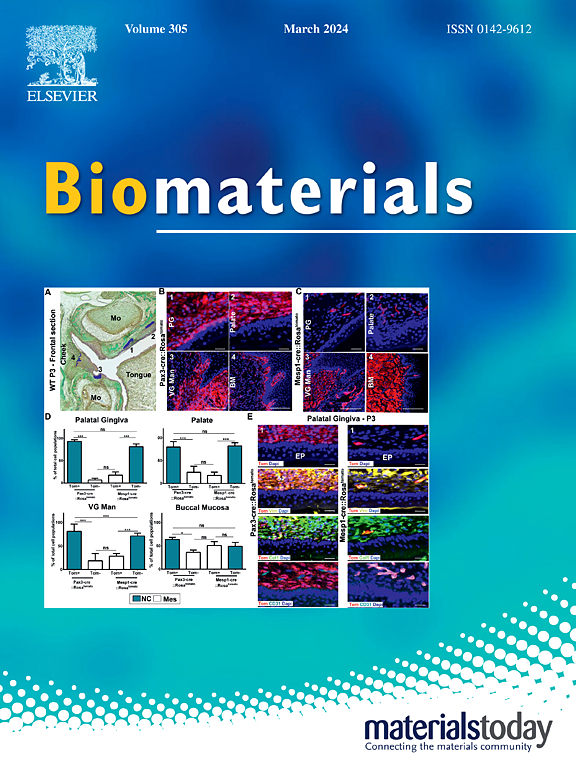CD38-targeted antibody-polymer drug conjugates for enhanced treatment of multiple myeloma
IF 12.8
1区 医学
Q1 ENGINEERING, BIOMEDICAL
引用次数: 0
Abstract
Multiple myeloma (MM) remains a formidable disease, especially in relapsed or refractory cases when there are limited treatment options. In this study, we introduce two polymer-antibody drug conjugates (pADCs), ISA-P-EPI (U6244-021) and DARA-P-EPI (U6244-031), which contain semitelechelic N-(2-hydroxypropyl)methacrylamide (HPMA) copolymer-epirubicin (EPI) conjugate attached to CD38-targeting antibodies Isatuximab (ISA) and Daratumumab (DARA). These pADCs enhance therapeutic efficacy by combining the specificity of ISA and DARA with the cytotoxic potency of EPI while preserving antibody function. The EPI is linked to the HPMA polymer backbone via a tetrapeptide spacer cleavable by lysosomal enzymes, enabling drug release upon endocytosis within tumor cells. This design achieves a higher drug-to-antibody ratio than conventional ADCs for safer delivery of drug payload.
In vitro studies demonstrate efficient binding, internalization, and cytotoxic efficacy of these pADCs in MM cell lines. Mechanistic investigations revealed significant therapeutic effects, including cell cycle arrest, immunogenic cell death, and preserved antibody-dependent cellular cytotoxicity (ADCC). In addition, pADCs were effective in 5 out of 8 primary samples, with their efficacy closely correlating with CD38 surface expression levels. To enhance therapeutic outcomes, we employed panobinostat to upregulate CD38 expression, which further improved pADC efficacy. In a preclinical NRG mouse model inoculated with MM.1S-luc cells, pADC treatment significantly delayed tumor progression and prolonged survival, with all treated mice remaining alive at the 100-day endpoint.
These findings underscore the potential of CD38-targeted pADCs as a novel approach to combining chemotherapy with immunotherapy for MM treatment, warranting further investigation into their optimization and clinical application.
cd38靶向抗体-聚合物药物偶联物增强多发性骨髓瘤的治疗
多发性骨髓瘤(MM)仍然是一种可怕的疾病,特别是在治疗方案有限的复发或难治性病例中。在这项研究中,我们引入了两种聚合物-抗体药物偶联物(pADCs), ISA- p -EPI (U6244-021)和DARA- p -EPI (U6244-031),它们含有半电子N-(2-羟丙基)甲基丙烯酰胺(HPMA)共聚物-表柔比星(EPI)偶联物,结合cd38靶向抗体Isatuximab (ISA)和Daratumumab (DARA)。这些padc通过将ISA和DARA的特异性与EPI的细胞毒性结合起来,在保留抗体功能的同时提高了治疗效果。EPI通过可被溶酶体酶切割的四肽间隔段与HPMA聚合物主链连接,使肿瘤细胞内吞作用释放药物。该设计实现了比传统adc更高的药物抗体比,从而更安全地递送药物有效载荷。体外研究表明,这些padc在MM细胞系中具有有效的结合、内化和细胞毒性作用。机制研究显示了显著的治疗效果,包括细胞周期阻滞、免疫原性细胞死亡和保留抗体依赖性细胞毒性(ADCC)。此外,pADCs在8个主要样本中有5个有效,其疗效与CD38表面表达水平密切相关。为了提高治疗效果,我们使用panobinostat上调CD38表达,进一步提高了pADC的疗效。在接种MM.1S-luc细胞的临床前NRG小鼠模型中,pADC治疗显著延缓了肿瘤进展并延长了生存期,所有治疗小鼠在100天终点均存活。这些发现强调了靶向cd38的pADCs作为化疗与免疫治疗联合治疗MM的新方法的潜力,值得进一步研究其优化和临床应用。
本文章由计算机程序翻译,如有差异,请以英文原文为准。
求助全文
约1分钟内获得全文
求助全文
来源期刊

Biomaterials
工程技术-材料科学:生物材料
CiteScore
26.00
自引率
2.90%
发文量
565
审稿时长
46 days
期刊介绍:
Biomaterials is an international journal covering the science and clinical application of biomaterials. A biomaterial is now defined as a substance that has been engineered to take a form which, alone or as part of a complex system, is used to direct, by control of interactions with components of living systems, the course of any therapeutic or diagnostic procedure. It is the aim of the journal to provide a peer-reviewed forum for the publication of original papers and authoritative review and opinion papers dealing with the most important issues facing the use of biomaterials in clinical practice. The scope of the journal covers the wide range of physical, biological and chemical sciences that underpin the design of biomaterials and the clinical disciplines in which they are used. These sciences include polymer synthesis and characterization, drug and gene vector design, the biology of the host response, immunology and toxicology and self assembly at the nanoscale. Clinical applications include the therapies of medical technology and regenerative medicine in all clinical disciplines, and diagnostic systems that reply on innovative contrast and sensing agents. The journal is relevant to areas such as cancer diagnosis and therapy, implantable devices, drug delivery systems, gene vectors, bionanotechnology and tissue engineering.
 求助内容:
求助内容: 应助结果提醒方式:
应助结果提醒方式:


